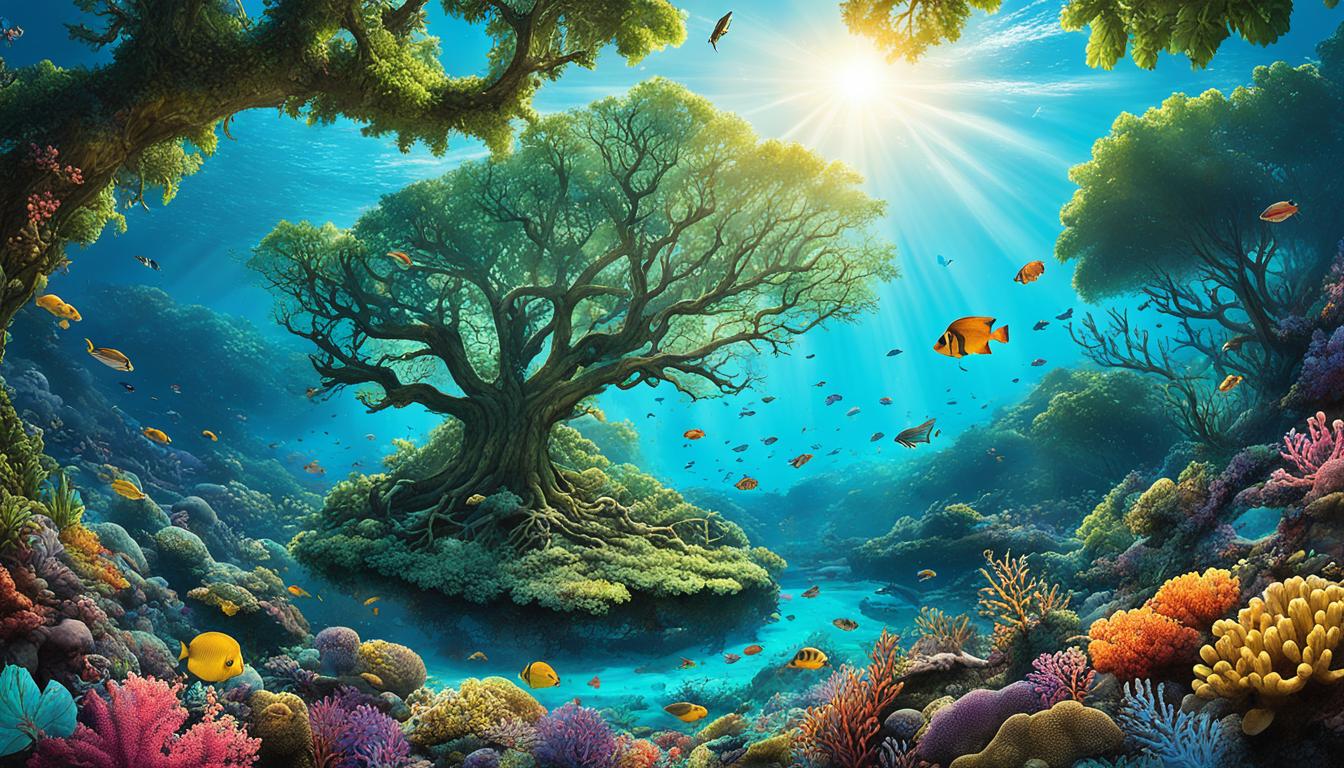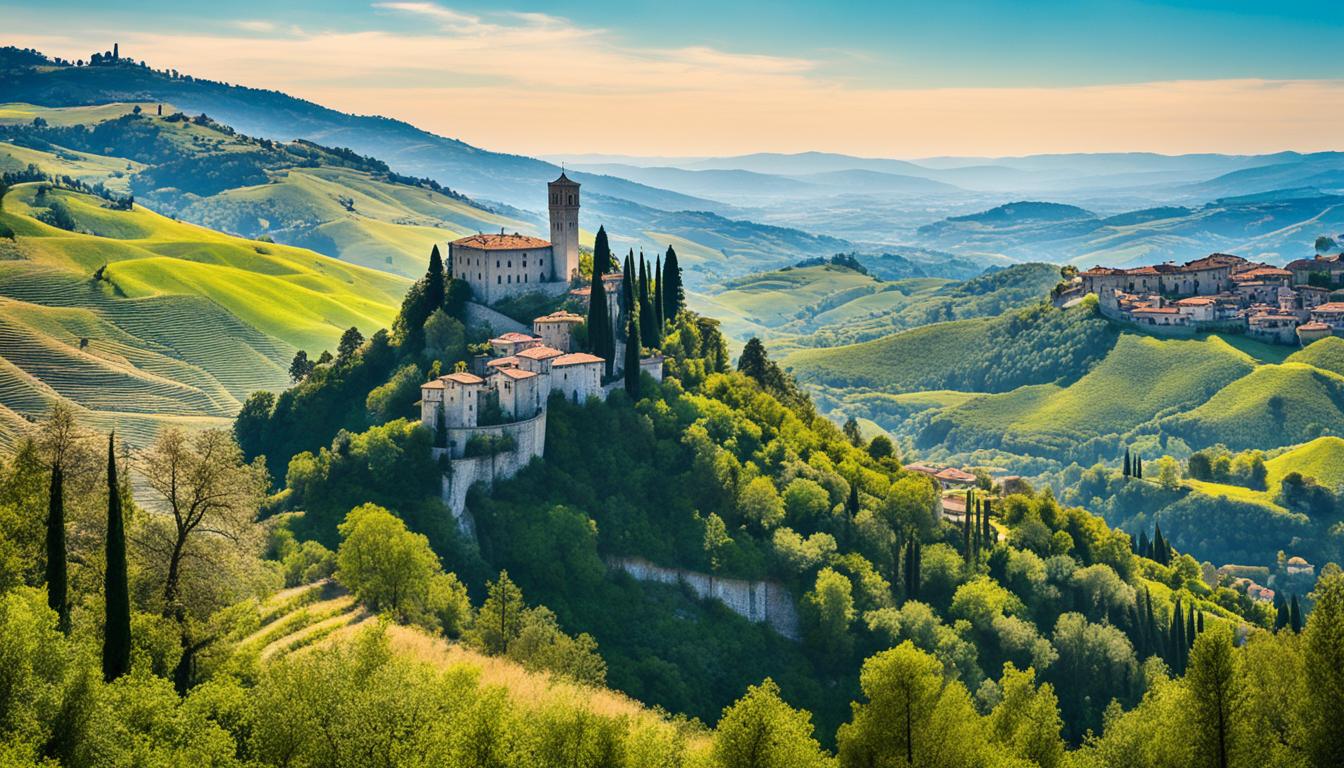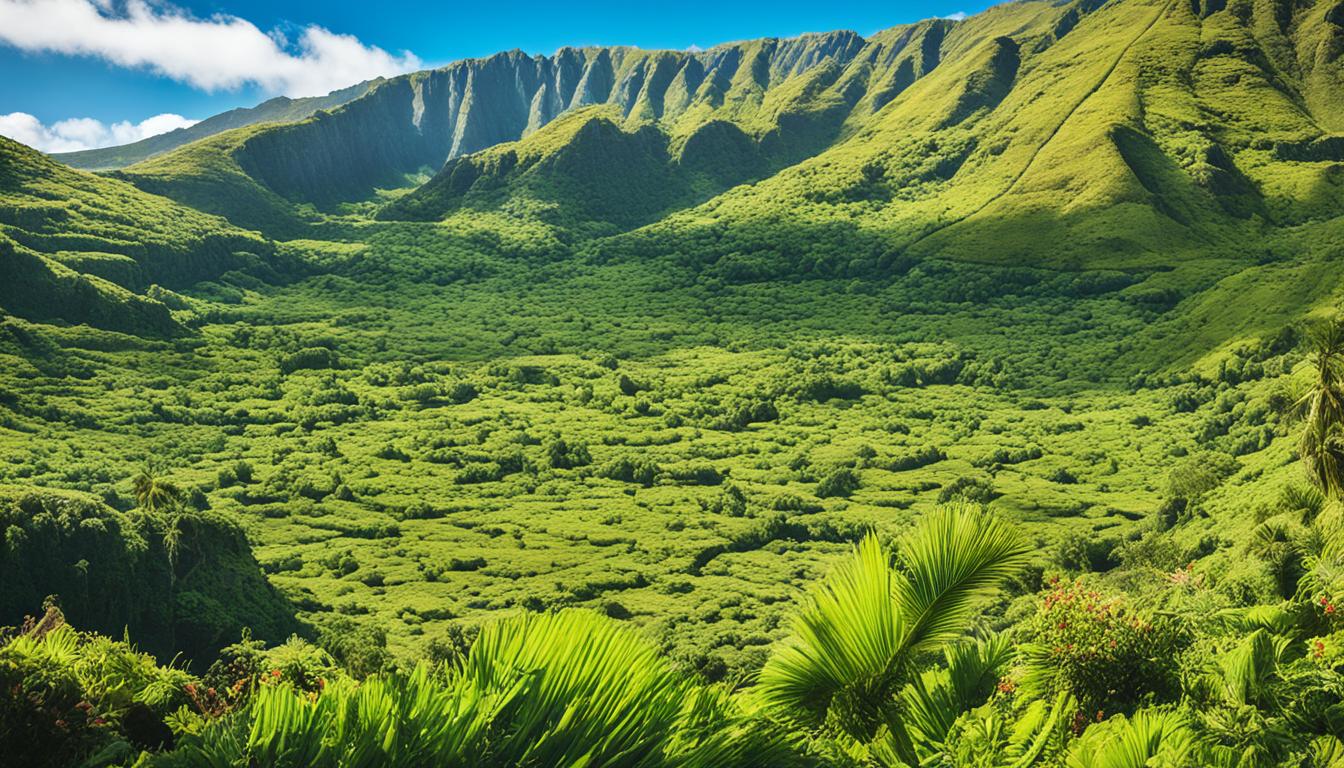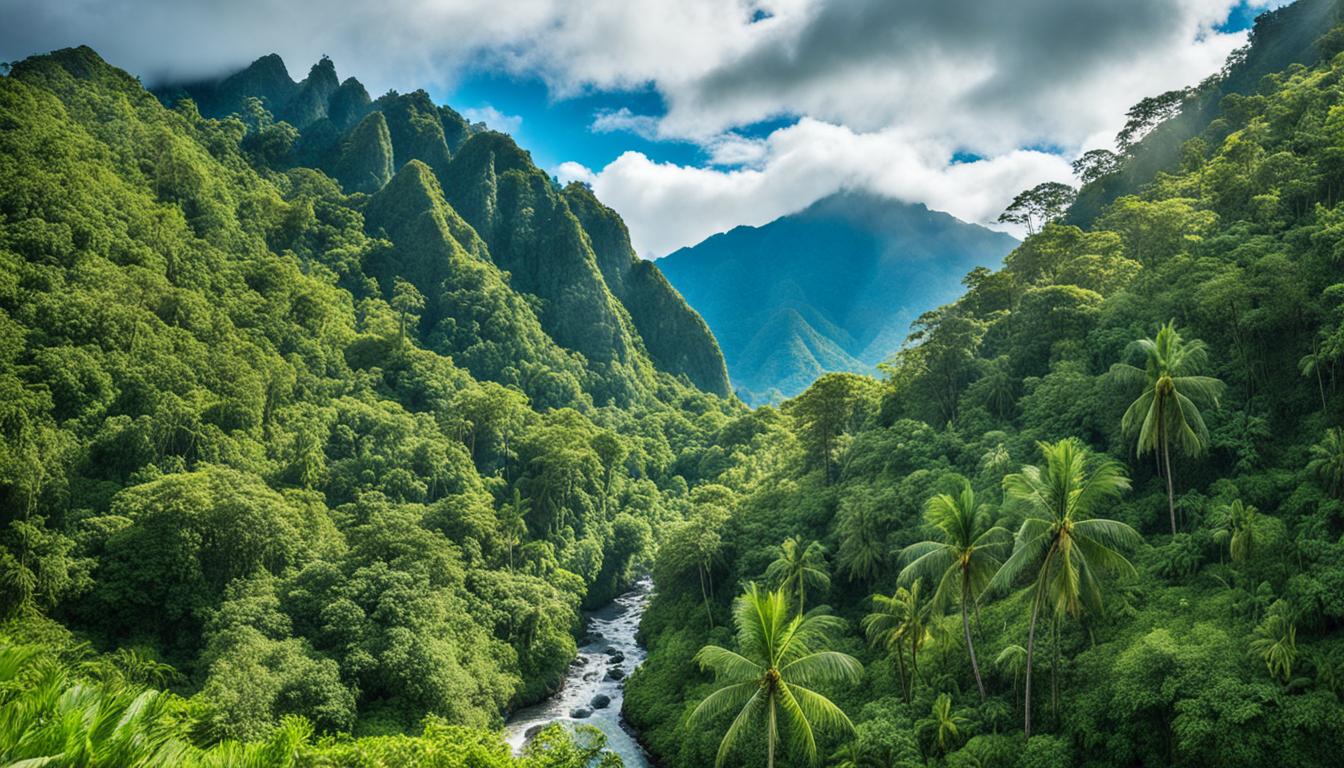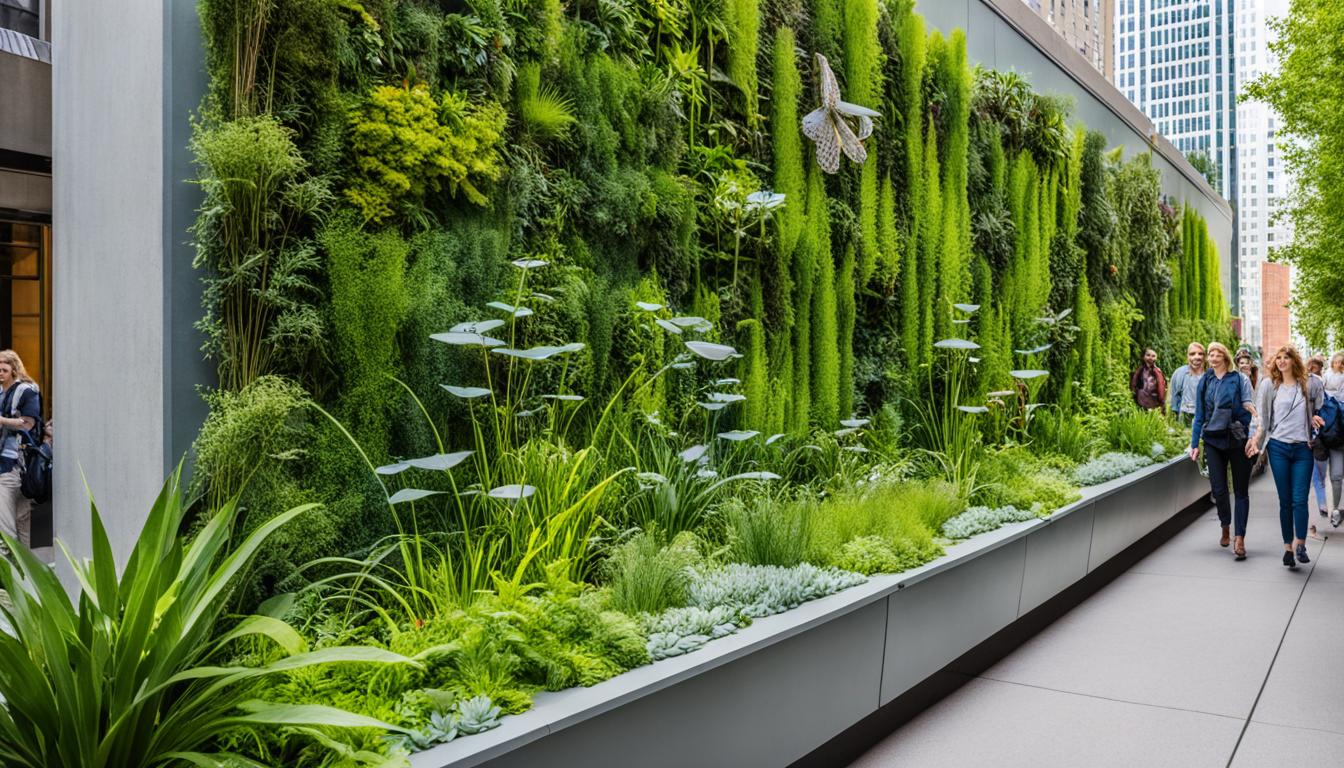Samoa Sacred Natural Sites and Biodiversity
Welcome to the hidden paradise of Samoa, where pristine beaches and crystal-clear waters are just the beginning. Prepare to be astounded, for within this tiny Pacific island nation lies an awe-inspiring secret. Did you know that Samoa is home to over 500 species of native flowering plants and 220 species of ferns? Yes, you read that right! The biodiversity of this tropical haven is truly remarkable.
However, this delicate balance of life is facing unprecedented threats. Deforestation, overexploitation of resources, climate change, and invasive species endanger Samoa’s natural heritage. Now, more than ever, conservation efforts and sustainable development practices are vital to safeguard the unique ecosystems and cultural landscapes of Samoa.
Key Takeaways:
- Samoa is home to over 500 species of native flowering plants and 220 species of ferns, contributing to its remarkable biodiversity.
- Conservation efforts are crucial to protect Samoa’s delicate ecosystems from threats such as deforestation, overexploitation of resources, climate change, and invasive species.
- Sustainable development practices are essential for preserving Samoa’s natural heritage and cultural landscapes.
- Collaboration between the government, conservation organizations, and local communities is key to ensuring the long-term sustainability of Samoa’s biodiversity.
- By prioritizing conservation and sustainable practices, Samoa can secure a future where its biodiversity continues to thrive, benefitting both humans and nature.
Flora Diversity in Samoa
Samoa’s flora is a magnificent display of biodiversity, with over 500 species of native flowering plants and 220 species of ferns. The diverse range of native flowering plants and ferns in Samoa contributes significantly to the country’s rich ecosystem.
Approximately 25% of the native plant species in Samoa are endemic, meaning they are found exclusively in this region. This high level of endemism highlights the unique ecological characteristics of Samoa and the need for conservation efforts to protect these valuable plants.
The vegetation in Samoa can be classified into five distinct plant communities, each with its own set of plant species adapted to the diverse climate and terrain. These plant communities include coastal strand vegetation, lowland rainforest, montane cloud forest, limestone forest, and wetland vegetation.
“The native flowering plants and ferns in Samoa play a crucial role in supporting local ecosystems by providing nectar, pollen, and food sources for insects, birds, and other wildlife.”
In addition to their aesthetic beauty, the native flowering plants and ferns in Samoa play a crucial role in supporting local ecosystems. These plants provide nectar, pollen, and food sources for insects, birds, and other wildlife, contributing to the overall health and balance of Samoa’s ecosystems.
To showcase the remarkable flora diversity in Samoa, below is a table highlighting some of the native flowering plants and fern species found in the various plant communities:
| Plant Community | Native Flowering Plants | Fern Species |
|---|---|---|
| Coastal Strand Vegetation | Pandanus tectorius | Asplenium nidus |
| Lowland Rainforest | Hibiscus tiliaceus | Davallia spp. |
| Montane Cloud Forest | Pritchardia spp. | Cibotium spp. |
| Limestone Forest | Hernandia spp. | Blechnum spp. |
| Wetland Vegetation | Scaevola sericea | Angiopteris spp. |
Samoa’s flora diversity and the intricate relationships between plant species and their ecosystems highlight the importance of conserving and protecting this natural heritage. By preserving Samoa’s unique flora, we not only ensure the survival of these plants but also contribute to the overall well-being and sustainability of the country’s ecosystems.
Unique Plant Species in Samoa
Samoa is home to several exceptional plant species that cannot be found anywhere else in the world. These plants, known as endemic plant species in Samoa, are a testament to the country’s distinct ecological characteristics and contribute significantly to its rich biodiversity. Protecting these unique plant species is vital for the long-term sustainability of Samoa’s flora diversity and plays a crucial role in biodiversity conservation in Samoa.
Endemic flora in Samoa showcases the country’s remarkable natural heritage, highlighting the need for conservation efforts to preserve these invaluable plant species. By safeguarding their habitats and implementing sustainable practices, Samoa can ensure the survival of these rare plants and promote the ecological balance of its ecosystems.
“The beauty and complexity of Samoa’s unique plant species are a testament to the country’s extraordinary biodiversity. It is our responsibility to protect and conserve these plants for future generations.”
– Dr. Thomas Green, Botanist
Furthermore, studying and exploring these unique plant species in Samoa offer immense opportunities for scientific discoveries and advancements in botany. Researchers and botanists can gain valuable insights into the ecological adaptations and evolutionary processes that have shaped these plants over time.
Safeguarding Samoa’s Endemic Plant Species
- Implementing conservation programs to protect the habitats of endemic plant species
- Creating protected areas and reserves
- Collaborating with local communities to raise awareness about the importance of biodiversity conservation
- Supporting scientific research and monitoring programs to identify and protect threatened plant species
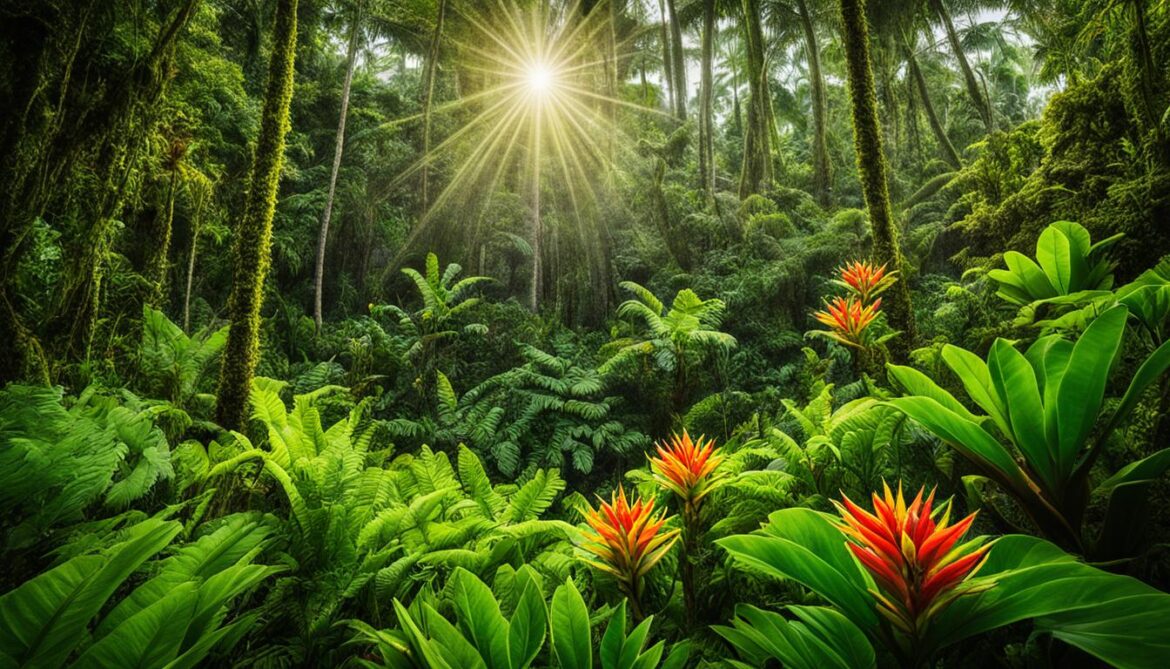
Concerted efforts are necessary to ensure the survival of unique plant species in Samoa and maintain the ecological richness of the country. By valuing and conserving these plants, Samoa can continue to be a haven for biodiversity, preserving its natural heritage for generations to come.
Conservation of Flora Diversity
Samoa recognizes the importance of preserving its valuable plant species and their habitats through various conservation measures. One of the key strategies is the establishment of protected areas, which serve as sanctuaries for the country’s unique flora and fauna. These protected areas not only safeguard endangered plant species but also provide critical habitat for a wide range of organisms, supporting the overall biodiversity of Samoa.
Sustainable agriculture practices play a crucial role in flora conservation in Samoa. The Samoan government, in collaboration with conservation organizations and local communities, promotes sustainable farming techniques that minimize the ecological impact on the land. By adopting sustainable agricultural practices, such as organic farming, crop rotation, and agroforestry, the Samoan people can ensure the long-term viability of their agricultural systems while preserving the natural environment.
“Conservation is the key to preserving Samoa’s unique flora diversity. By safeguarding protected areas and implementing sustainable agriculture practices, we can protect our valuable plant species and contribute to the overall ecological sustainability of our beautiful country.” – Dr. Leao Tuitama, Minister of Natural Resources and Environment
Research and monitoring programs are integral to flora conservation in Samoa. These initiatives help identify and protect threatened plant species, allowing for targeted conservation efforts. By closely studying the dynamics of Samoa’s plant populations, researchers and conservationists can develop effective strategies to ensure the survival and recovery of endangered species.
Protected Areas in Samoa
To provide a comprehensive overview of Samoa’s protected areas, their significance, and the species they harbor, the following table highlights some of the key protected areas in the country:
| Protected Area | Location | Key Plant Species | Conservation Status |
|---|---|---|---|
| Falealupo Rainforest Reserve | Savai’i Island | Giant Banyan Trees, Native Orchids | Strict Protection |
| O le Pupu-Pue National Park | Upolu Island | Mountain Banyan Trees, Native Ferns | Protected Landscape |
| Afono Conservation Area | Tutuila Island | Native Palms, Medicinal Plants | Community Conservation |
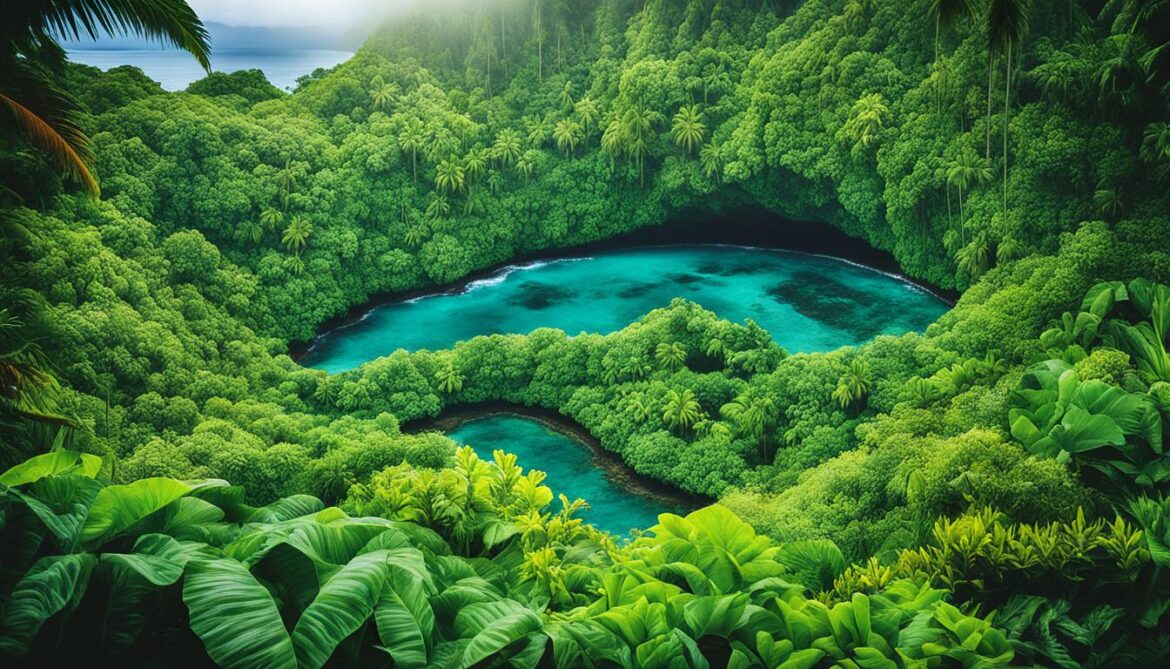
Faunal Diversity in Samoa
Samoa boasts a diverse range of fauna, encompassing various species of terrestrial mammals, land birds, seabirds, reptiles, insects, land snails, and fish. These remarkable creatures contribute significantly to the ecological richness and overall biodiversity of Samoa’s vibrant ecosystems.
One notable group of terrestrial mammals found in Samoa is the Pacific fruit bat, also known as the flying fox. These fascinating creatures play a vital role in seed dispersal and pollination, contributing to the health and diversity of Samoa’s forests.
Samoa is also home to an array of land birds, including several endemic species that are unique to the islands. One such bird is the tooth-billed pigeon, which holds the honor of being Samoa’s national bird. Its striking appearance and melodic calls make it a cherished symbol of Samoan wildlife.
The coastal and marine environments of Samoa teem with life, with numerous seabird species taking to the skies and thriving in this abundant habitat. These seabirds play a crucial role in nutrient cycling and ecosystem dynamics, making them essential contributors to Samoa’s marine biodiversity.
Reptiles, such as geckos and skinks, are also found in Samoa, adding to the country’s faunal diversity. These reptiles have adapted to various habitats, including forests, coastal areas, and even urban environments.
Insects, with their vast numbers and incredible diversity, form a significant part of Samoa’s fauna. From colorful butterflies to busy ants and buzzing bees, these tiny creatures play vital roles in pollination, decomposition, and maintaining the delicate balance of Samoa’s ecosystems.
The land snails of Samoa are equally unique and diverse, with numerous species inhabiting the lush forests and hidden crevices of the islands. Although some of these snails are endemic to Samoa, many are threatened by habitat loss and invasive species.
Lastly, Samoa’s marine environment is home to a wide range of fish species, which thrive in the vibrant coral reefs and coastal waters. These fish contribute to the resilience and beauty of Samoa’s marine ecosystems, forming intricate food webs and providing livelihoods for local communities.
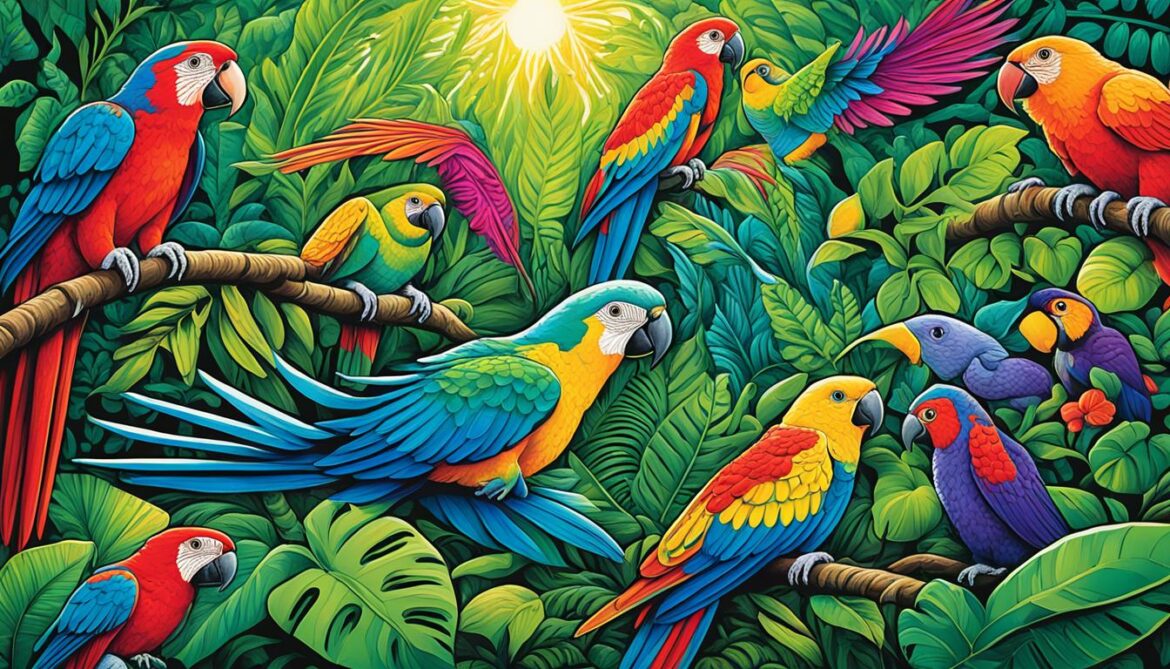
Protecting Samoa’s Faunal Diversity
“The richness of Samoa’s faunal diversity is a testament to the resilience and interconnectedness of its ecosystems. Conservation efforts are crucial to safeguarding these diverse species and their habitats.” – Conservation Officer
Preserving Samoa’s faunal diversity requires a collaborative approach that involves government initiatives, conservation organizations, local communities, and responsible tourism practices. By promoting sustainable land and marine management, creating protected areas, and implementing measures to prevent the introduction of invasive species, Samoa can ensure the long-term survival of its unique fauna.
Additionally, ongoing research and monitoring programs play a pivotal role in understanding the needs and vulnerabilities of Samoa’s fauna. These insights help inform conservation strategies and enable targeted actions to protect endangered and endemic species.
Samoa’s faunal diversity is not only a valuable natural asset but also an integral part of the country’s cultural heritage. Respecting and preserving the delicate balance between humans and nature is essential for the well-being of both. Through collective efforts and a shared commitment to sustainability, Samoa can cherish and protect its diverse fauna for generations to come.
The Rich Fauna of Samoa
Samoa’s faunal diversity, from terrestrial mammals to colorful land birds, reptiles, insects, land snails, and fish, captivates and inspires. The country is home to a wide range of species, both endemic and unique to this region. Protecting this diverse range of species is crucial for maintaining the delicate ecological balance and preserving Samoa’s natural heritage.
With its lush rainforests, pristine rivers, and stunning coastlines, Samoa provides a perfect habitat for a rich variety of faunal species. From the agile Samoan fruit bat to the vibrant flycatchers and the impressive coconut crab, these remarkable creatures contribute to the ecological richness of the islands.
Efforts to conserve the fauna in Samoa involve a combination of scientific research, habitat preservation, and community engagement. Conservation organizations and local communities collaborate to establish protected areas, monitor population trends, and implement sustainable practices. These initiatives aim to ensure the long-term survival and sustainability of these precious species.
Notable Fauna Species in Samoa
Samoa is known for its remarkable range of endemic species, found nowhere else in the world. These unique creatures are a testament to the distinctiveness of Samoa’s ecosystems and highlight the need for their conservation. Some of the notable endemic species in Samoa include:
- The Samoan flying fox (Pteropus samoensis) – A large fruit bat found throughout the Samoan Islands.
- The Manumea (Didunculus strigirostris) – Also known as the tooth-billed pigeon, it is the national bird of Samoa.
- The Samoan tree snail (Partula taeniata) – A brightly colored land snail that inhabits the rainforests of Samoa.
- The Samoan coral reef fish – An array of colorful fish species that thrive in Samoa’s vibrant coral reefs.
- The Pacific boa (Candoia bibroni) – A non-venomous snake found in Samoa’s forests.
These and many other unique species showcase the incredible biodiversity found in Samoa and underscore the importance of conservation efforts. By protecting their habitats and implementing sustainable practices, we can ensure the continued existence of these fascinating creatures for generations to come.
Conservation of Fauna in Samoa
The conservation of fauna in Samoa is a collaborative effort involving government agencies, conservation organizations, and local communities. Conservation initiatives focus on the following key areas:
- Protected Areas: By designating specific areas as protected, Samoa aims to preserve critical habitats and restrict activities that may harm the fauna.
- Community Engagement: Involving local communities in conservation efforts fosters a sense of ownership and responsibility towards protecting the fauna. This includes education programs, capacity-building workshops, and sustainable livelihood initiatives.
- Research and Monitoring: Continuous research and monitoring help assess the status of different species, identify threats, and implement targeted conservation strategies.
- Habitat Restoration: Restoring degraded habitats ensures the availability of suitable environments for the fauna to thrive.
By implementing these strategies and raising awareness about the importance of wildlife conservation, Samoa is taking significant steps to safeguard its rich fauna and preserve its natural heritage. Through these collective efforts, we can ensure the long-term survival and sustainability of the diverse range of species that call Samoa home.
| Threats to Fauna in Samoa | Action Steps |
|---|---|
| Habitat loss due to deforestation | Implement reforestation and habitat restoration programs |
| Invasive species | Monitor and control the spread of invasive species, particularly in sensitive ecosystems |
| Climate change and habitat disruption | Promote sustainable practices to mitigate climate change impacts and improve habitat resilience |
| Overhunting and illegal wildlife trade | Enforce strict regulations and raise awareness about the negative consequences of these activities |
Marine Biodiversity in Samoa
Samoa’s coastal and marine ecosystems are thriving with a diverse range of marine species, making it a true haven for marine biodiversity. The country is blessed with the presence of 14 families of corals and at least 45 identified coral species. These vibrant coral reefs are not only a breathtaking sight but also provide vital habitats for countless marine organisms, contributing to the overall ecological richness of Samoa’s marine ecosystems.
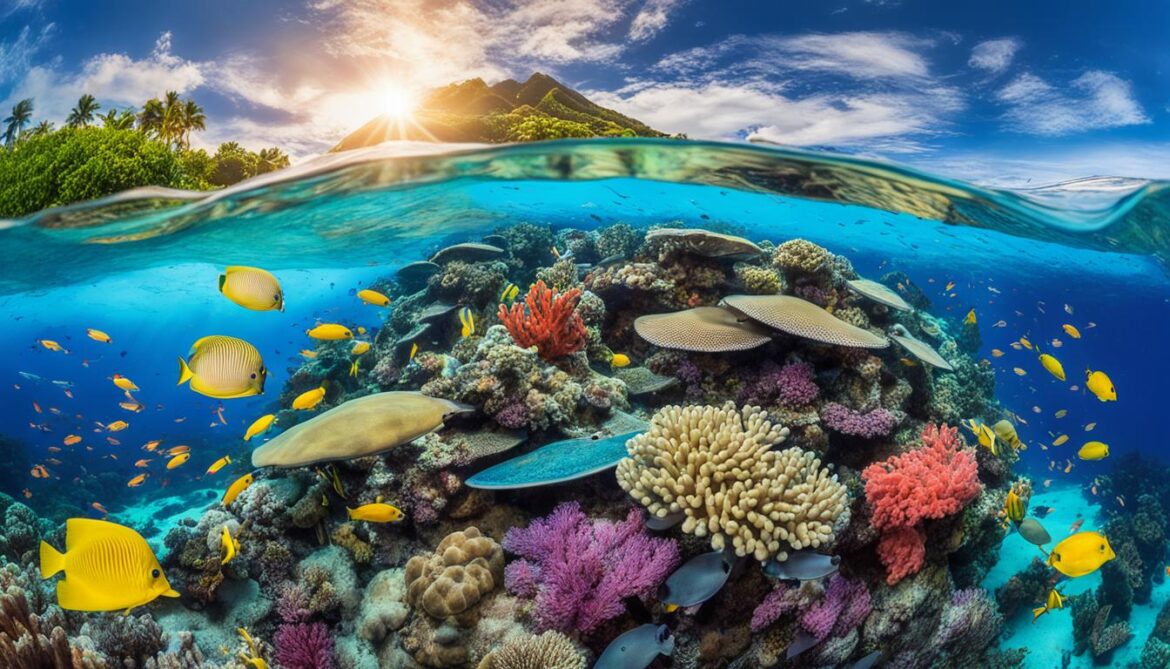
However, Samoa’s marine biodiversity faces significant threats that jeopardize the delicate balance of these ecosystems. Overfishing, coastal development, and the impacts of climate change pose substantial challenges to the wellbeing of Samoa’s marine species and their habitats.
“The loss of coral reefs will have far-reaching consequences for marine biodiversity and the communities that rely on these ecosystems for their livelihoods.”
Overfishing, driven by increasing demands for seafood, can lead to the depletion of fish populations and disrupt the intricate food webs within marine ecosystems. Coastal development, including the construction of resorts and infrastructure, often results in habitat destruction and pollution, further compromising the health of coral reefs and other marine habitats. Climate change, with rising sea temperatures and ocean acidification, poses grave risks to coral reefs, making them more susceptible to bleaching and disease.
Conservation of Marine Ecosystems
Sustaining Samoa’s marine biodiversity requires the implementation of effective conservation measures and the promotion of sustainable practices. Through collaborative efforts, such as stakeholder engagement, education, and policy reforms, the protection and preservation of marine ecosystems can be achieved.
Promoting sustainable fishing practices, including the establishment of marine protected areas and implementing responsible fishing strategies, is crucial for maintaining fish populations and ensuring the long-term sustainability of Samoa’s fisheries. Additionally, reducing pollution and controlling coastal development activities are vital for preserving the integrity of marine habitats and safeguarding the interconnected web of species that rely on them.
By addressing the challenges of overfishing, coastal development, and climate change, Samoa can pave the way for a more resilient and vibrant marine ecosystem. The conservation of marine biodiversity not only benefits the environment but also supports the livelihoods and well-being of local communities who depend on these resources for food, cultural practices, and tourism.
Threatened Coral Species in Samoa
Samoa’s coral reefs are home to a diverse range of marine life and play a vital role in supporting the local ecosystem. However, several coral species in Samoa are currently under threat due to various factors, including habitat destruction, overfishing, and the impacts of climate change. It is essential to implement targeted conservation efforts to ensure the survival of these threatened coral species and the preservation of Samoa’s precious coral reefs.
The Samoan government, in collaboration with conservation organizations, is actively working towards the conservation of these vulnerable coral species and their habitats. Through research, monitoring, and the establishment of marine protected areas, they aim to mitigate the threats and promote the recovery of these coral populations. By raising awareness and engaging local communities in coral conservation efforts, Samoa is taking proactive steps to safeguard its marine biodiversity for future generations.
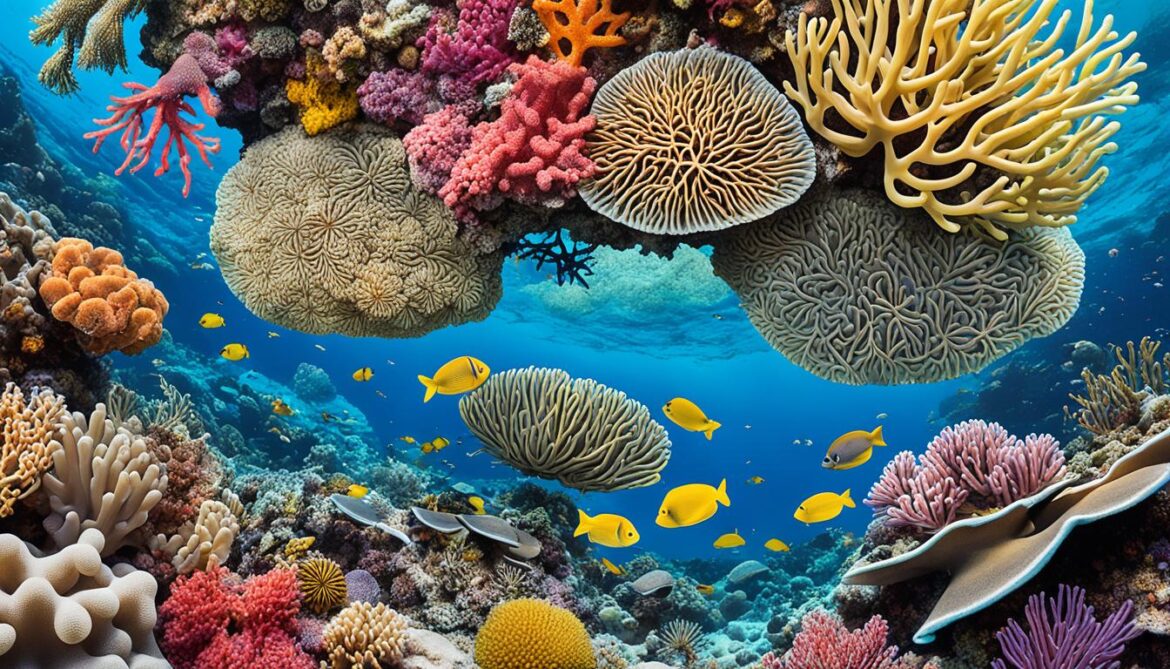
The Importance of Samoa’s Traditional Conservation Practices
Samoa’s traditional conservation practices, rooted in the Faa-Samoa (Samoan way of life), play a vital role in protecting and conserving the country’s natural environment. In Samoa, the cultural significance of conservation is deeply ingrained in the local governance system, guided by chiefs (matai). This system ensures the sustainable use of resources and the preservation of cultural landscapes, fostering a harmonious relationship between the Samoan people, their traditions, and the natural world.
The application of traditional conservation practices in Samoa strengthens the connection between the people and their environment. These practices are built upon a deep respect for nature and a profound understanding of the interconnectedness between humans and the natural world. By embracing and preserving these traditional practices, Samoa not only protects its biodiversity but also enhances its cultural identity and sense of belonging.
“Our ancestors passed down the wisdom of Faa-Samoa, teaching us the importance of nurturing and preserving our natural environment. Through the practice of traditional conservation, we honor our cultural heritage and ensure the sustainable future of our beloved Samoa.”
The local governance system ensures that decisions regarding conservation are made collectively and with community input, giving individuals a sense of ownership and responsibility for the protection of their natural resources. This bottom-up approach empowers local communities to actively participate in and contribute to conservation efforts, fostering a sense of pride and shared commitment to preserving Samoa’s unique ecosystems.
The cultural significance of conservation in Samoa extends beyond the protection of flora and fauna. It encompasses the safeguarding of cultural sites, sacred natural sites, and traditional knowledge related to the sustainable use of resources. These practices not only preserve the physical landscapes but also maintain the spiritual and historical connection between the Samoan people and their ancestral lands.
Local Governance and Faa-Samoa
Local governance, driven by the Faa-Samoa principles, serves as the foundation for conservation practices in Samoa. The matai system, with its hierarchical structure and communal decision-making, plays a central role. Chiefs (matai) are entrusted with the responsibility of guiding their communities in the sustainable use of resources and the conservation of natural habitats.
The matai exercise their leadership by implementing customary laws and regulations that protect the environment. These regulations often involve restrictions on the exploitation of certain resources, seasonal fishing and farming practices, and the establishment of taboo areas to allow for natural regeneration. By integrating traditional knowledge and practices into modern conservation efforts, Samoa ensures the longevity of its cultural and ecological heritage.
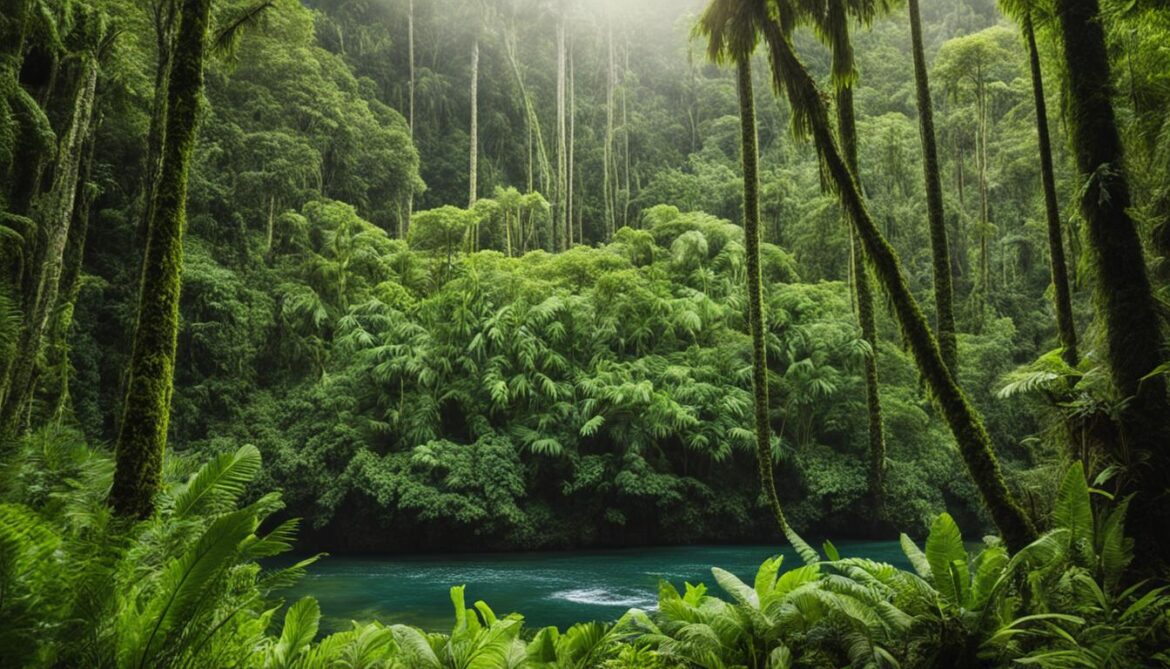
The cultural significance of conservation in Samoa is not just a historical relic, but an evolving and vibrant expression of the Samoan way of life. It is a living testament to the deep-rooted connection between the Samoan people, their customs, and the natural world they call home.
The Role of Conservation Organizations in Samoa
Conservation organizations in Samoa play a vital role in protecting the country’s unique ecosystems and cultural heritage. Through close collaboration with local communities, these organizations raise awareness about the importance of biodiversity conservation and implement sustainable practices to ensure the long-term sustainability of Samoa’s natural resources.
Working hand in hand with the Samoan government and local communities, conservation organizations contribute towards the establishment of protected areas, research and monitoring programs, and the promotion of sustainable development practices. Their efforts aim to preserve Samoa’s rich biodiversity and safeguard the delicate balance of its ecosystems.
By collaborating with local communities, conservation organizations have a more comprehensive understanding of the challenges and opportunities in conservation. They empower communities to actively participate in conservation efforts, strengthening the connection between people and the environment.
“Conservation organizations, in collaboration with local communities, have the unique ability to harness the collective knowledge and skills necessary for effective conservation. Together, we can make a difference in preserving Samoa’s natural heritage for future generations.” – Dr. Jane Goodall, Founder of the Jane Goodall Institute
Raising awareness is a key focus for conservation organizations in Samoa. By organizing educational programs, workshops, and community engagement activities, they inform local communities about the importance of conservation and inspire individuals to take action. These efforts not only benefit the environment but also contribute to the overall well-being and sustainable development of Samoa.
Collaboration with Local Communities
Collaboration with local communities is at the core of conservation efforts in Samoa. By involving communities in decision-making processes, conservation organizations ensure that the needs and aspirations of the local people are considered in conservation planning. Through this inclusive approach, they foster a sense of ownership and responsibility among community members, creating a sustainable framework for conservation practices.
Conservation organizations also work closely with local communities to develop sustainable livelihood options that are compatible with conservation goals. By promoting eco-tourism, sustainable agriculture, and environmentally friendly practices, they empower communities to benefit from the protection of their natural resources without compromising the integrity of the ecosystems.
Raising Awareness in Conservation
Raising awareness is a fundamental aspect of conservation work in Samoa. Conservation organizations utilize various communication channels, including social media, workshops, and community events, to educate and engage the public. These efforts focus on highlighting the value of biodiversity, the importance of ecosystem services, and the impacts of environmental degradation.
Through these initiatives, conservation organizations aim to instill a sense of pride and stewardship among the Samoan population. By showcasing the beauty and significance of Samoa’s natural heritage, they inspire individuals to actively participate in conservation activities and contribute to the overall sustainability of the country.
Conservation Organizations in Samoa
| Organization | Focus Areas | Website |
|---|---|---|
| Samoan Conservation Society | Protected areas management, community engagement | www.samoaconservation.org |
| Conservation International Samoa | Biodiversity conservation, sustainable development | www.conservation.org/samoa |
| Samoa Environmental Society | Educational programs, awareness campaigns | www.environmentalsociety.org |
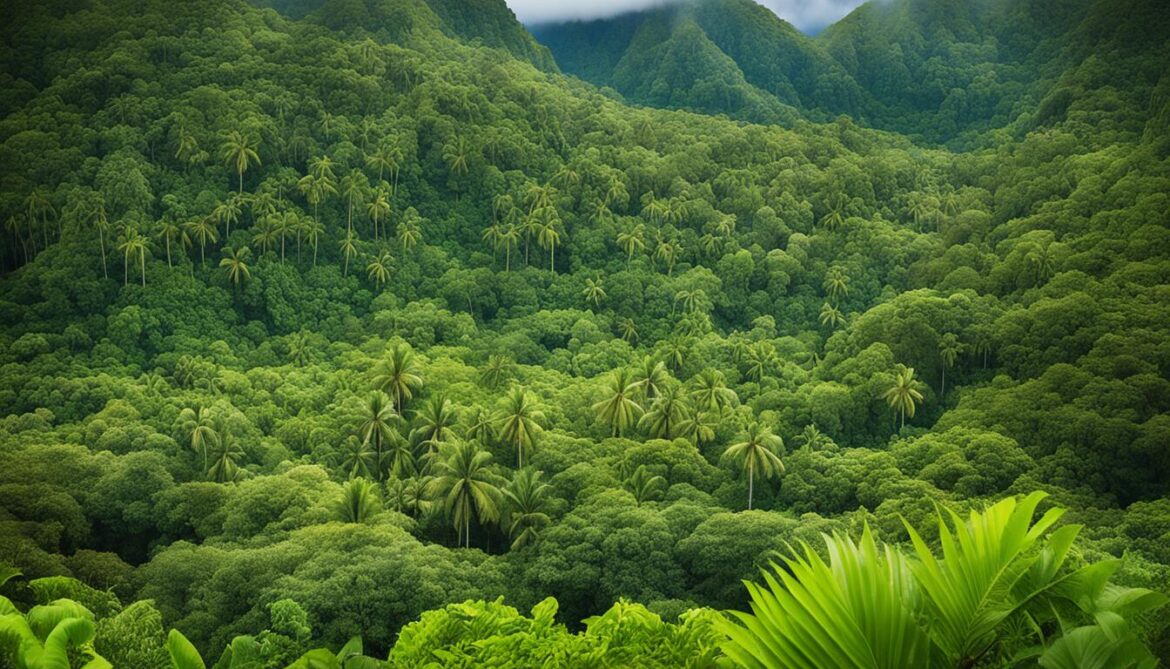
The collaboration between conservation organizations and local communities in Samoa is a testament to the collective dedication towards biodiversity conservation. Through their tireless efforts, these organizations promote sustainable practices, raise awareness, and create a sustainable future for Samoa’s natural heritage.
Future Challenges and Opportunities for Samoa’s Biodiversity Conservation
As Samoa strives to conserve its rich biodiversity, it faces a range of ongoing challenges. Deforestation, overexploitation of resources, climate change, and invasive species all threaten the delicate balance of Samoa’s ecosystems. To overcome these challenges and ensure the long-term sustainability of its biodiversity, Samoa must continue its efforts in conservation and sustainable development.
One of the key opportunities for Samoa lies in collaboration. By fostering partnerships between the government, conservation organizations, and local communities, Samoa can harness collective knowledge and resources. This collaboration can lead to more effective conservation strategies and enhanced community engagement in biodiversity conservation.
Moreover, sustainable development plays a vital role in safeguarding Samoa’s biodiversity. By prioritizing sustainable practices in sectors such as agriculture, tourism, and infrastructure, Samoa can mitigate the negative impacts on its ecosystems while fostering economic growth.
“Sustainable development is not a choice but a necessity for Samoa’s future. We must find innovative solutions that balance economic growth with environmental stewardship.”
— Minister of Environment, Samoa
Challenges and Opportunities
| Challenges | Opportunities |
|---|---|
| Deforestation | Collaboration for reforestation projects |
| Overexploitation of resources | Promoting sustainable harvesting practices |
| Climate change | Adaptation strategies and resilience building |
| Invasive species | Invasive species management and eradication efforts |
By addressing these challenges and embracing the opportunities, Samoa can pave the way for a sustainable future. Through focused conservation efforts, including the protection of endemic species and the establishment of marine protected areas, Samoa can safeguard its unique natural heritage for generations to come.
Conclusion
Samoa’s sacred natural sites and biodiversity are a remarkable reflection of the country’s rich ecological diversity and cultural heritage. With its unique and diverse flora and fauna, Samoa offers a captivating glimpse into the wonders of the natural world. However, the preservation of Samoa’s biodiversity requires sustained conservation efforts and the implementation of sustainable development practices.
By working collaboratively, including the government, conservation organizations, and local communities, we can pave the way for a future where Samoa’s biodiversity thrives. Together, we can ensure the well-being of both humans and nature, safeguarding the future of Samoa’s precious ecosystems.
The path ahead lies in prioritizing biodiversity conservation and sustainable practices. By fostering strong partnerships and harnessing the power of collective action, Samoa can continue to protect its unique natural heritage for generations to come. Let us embrace this opportunity to create a future where Samoa’s biodiversity flourishes, enriching our shared planet.



